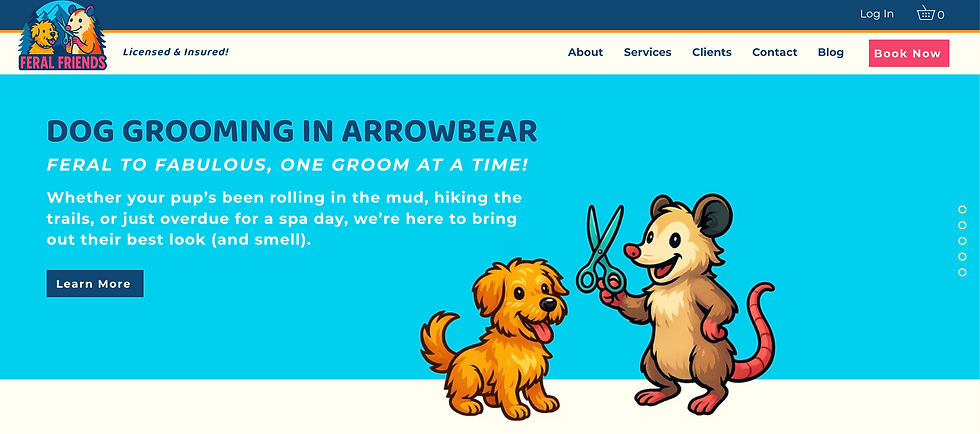Web Design Trends for 2025
- Border7 Studios

- Aug 6, 2024
- 4 min read
Designing for the End User to Encourage Conversions
Staying ahead of web design trends is crucial for maintaining a competitive edge and ensuring that your website meets the needs and expectations of your users.
There are many stunning templates and websites out there, but if they don't convert visitors into customers, they're just art pieces, not business assets.

As we look towards 2025, the focus on designing for the end user to encourage conversions is more important than ever.
In this blog post, we'll cover the key web design trends for 2025 and how they can help you create a user-centric website that drives engagement and boosts conversions.
1. Personalized User Experiences
Personalization is no longer a luxury; it's a necessity. In 2025, web design will increasingly prioritize personalized user experiences.
This means tailoring content, design elements, and interactions to individual users based on their behavior, preferences, and past interactions with your site.
Dynamic Content: Use dynamic content that changes based on user data, such as location, browsing history, and previous purchases. This can make your website feel more relevant and engaging to each visitor.
AI and Machine Learning: Implement AI-driven recommendations and predictive analytics to anticipate user needs and offer personalized solutions, increasing the likelihood of conversions.
2. Advanced Micro-Interactions
Micro-interactions are subtle animations or responses that occur when users interact with your website. These can enhance the user experience by providing feedback, guiding navigation, and adding a layer of interactivity.
Hover Effects and Button Animations: Use hover effects and animated buttons to make interactions more engaging and intuitive. This can help draw attention to key calls-to-action (CTAs) and encourage clicks.
Loading Animations: Implement loading animations that keep users entertained and informed while waiting for content to load. This can reduce bounce rates and improve overall user satisfaction.
3. Minimalistic and Functional Design
While minimalism has been a trend for some time, 2025 will see a shift towards minimalistic designs that are not only aesthetically pleasing but also highly functional. The goal is to remove any unnecessary elements that could distract or confuse users.
Simplified Navigation: Streamline your navigation menus to make it easier for users to find what they're looking for. Use clear labels and intuitive structures to guide users effortlessly.
Whitespace: Leverage whitespace to create a clean, uncluttered look. This can help highlight important content and CTAs, making it easier for users to focus on what matters most.

4. Voice User Interface (VUI) Integration
With the growing popularity of voice assistants, integrating Voice User Interface (VUI) into your web design will become increasingly important.
VUI can enhance accessibility and provide a more natural way for users to interact with your site.
Voice Search Optimization: Optimize your website for voice search by using conversational keywords and phrases. This can help capture traffic from users who prefer voice commands over typing.
Voice-Activated Navigation: Implement voice-activated navigation to allow users to browse your site hands-free. This can improve accessibility for users with disabilities and provide a more convenient experience for all.
5. Inclusive and Accessible Design
Designing for inclusivity and accessibility is not only ethically important but also essential for reaching a broader audience.
In 2025, web design will continue to prioritize creating websites that are usable by everyone, regardless of their abilities or disabilities.
Alt Text and ARIA Labels: Ensure all images have descriptive alt text and use ARIA labels to improve navigation for screen reader users.
Color Contrast and Readability: Use high-contrast color schemes and legible fonts to enhance readability for users with visual impairments.
6. Immersive and Interactive Storytelling
Storytelling through immersive and interactive design elements will captivate users and encourage them to spend more time on your site.
This can be particularly effective for brands looking to create a strong emotional connection with their audience.
Parallax Scrolling and 3D Elements: Use parallax scrolling and 3D elements to create a sense of depth and engagement. This can make your website more visually appealing and memorable.
Interactive Infographics and Videos: Incorporate interactive infographics and videos that allow users to engage with your content in a meaningful way. This can enhance understanding and retention of information, leading to higher conversion rates.
7. Data-Driven Design Decisions
Leveraging data to inform your design decisions will be critical in 2025. By analyzing user behavior and feedback, you can make informed changes that improve the user experience and drive conversions.
A/B Testing: Conduct A/B testing to compare different design elements and determine which versions perform better. This can help you optimize your site for maximum conversions.
User Feedback and Analytics: Regularly collect and analyze user feedback and website analytics to identify pain points and areas for improvement. Use this data to make iterative design changes that enhance the user experience.
Focus on Personalized User Experiences
As we move into 2025, the importance of designing for the end user to encourage conversions cannot be overstated.
By embracing trends such as personalized user experiences, advanced micro-interactions, minimalistic and functional design, VUI integration, inclusive and accessible design, immersive storytelling, and data-driven decisions, you can create a website that not only meets but exceeds user expectations.
Focus on the needs and preferences of your users, and you'll be well on your way to building a successful online presence that drives engagement and boosts conversions.





